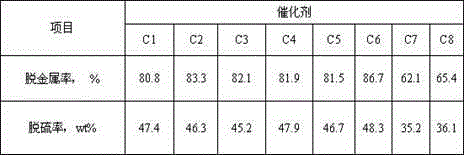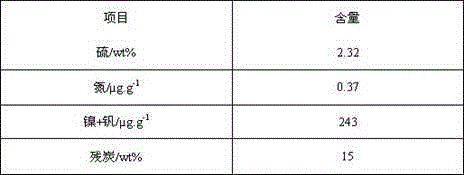Preparation method for residual oil hydrogenation and demetalization catalyst
A technology for hydrodemetallization and residual oil hydrogenation, which is used in metal/metal oxide/metal hydroxide catalysts, chemical instruments and methods, physical/chemical process catalysts, etc., and can solve problems such as unsatisfactory mechanical strength of catalysts
- Summary
- Abstract
- Description
- Claims
- Application Information
AI Technical Summary
Problems solved by technology
Method used
Image
Examples
example 1
[0018] Weigh 100 grams of the above-mentioned self-made clover-shaped alumina (25% water content), use 150ml containing 15 grams of xylitol, MoO 3 The impregnating solution of 105 g and 15 g of NiO is immersed in the above-mentioned carrier for 3 hours. The excess solution is filtered off and dried at 110°C for 8 hours. The dried material is calcined at 260°C for 4 hours in a nitrogen atmosphere, and then in a nitrogen atmosphere. It is fired at 600°C for 4 hours, and finally fired at 400°C for 3 hours in an air atmosphere. The residue hydrodemetalization catalyst C1 of the present invention is prepared.
example 2
[0020] Same as Example 1, except that the dipping solution contains 25 grams of sorbitol, mannitol, and arabinol in a mass ratio of 1:1:1 to prepare the residue hydrodemetalization catalyst C2 of the present invention.
example 3
[0022] The same as Example 1, except that the impregnation solution contains 8 grams of glucose, the residue hydrodemetalization catalyst C3 of the present invention is prepared.
PUM
| Property | Measurement | Unit |
|---|---|---|
| length | aaaaa | aaaaa |
| diameter | aaaaa | aaaaa |
| specific surface area | aaaaa | aaaaa |
Abstract
Description
Claims
Application Information
 Login to View More
Login to View More - R&D
- Intellectual Property
- Life Sciences
- Materials
- Tech Scout
- Unparalleled Data Quality
- Higher Quality Content
- 60% Fewer Hallucinations
Browse by: Latest US Patents, China's latest patents, Technical Efficacy Thesaurus, Application Domain, Technology Topic, Popular Technical Reports.
© 2025 PatSnap. All rights reserved.Legal|Privacy policy|Modern Slavery Act Transparency Statement|Sitemap|About US| Contact US: help@patsnap.com


